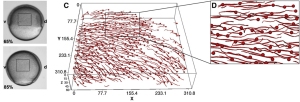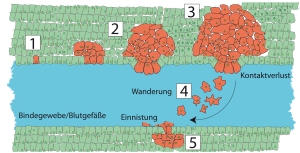How do cells separate from one another during tissue formation?
Once a progenitor cell has committed for a certain type, it differentiates and can in principle give rise to any cell type. Mesenchymal stem cell, depending on the mechanical input, give rise to neurons, muscles or bone cells. Unfortunately, the events that lead to differentiation and development are more complex and not entirely understood. An interplay of chemical and mechanical signal are needed to pattern a seemingly unstructured embryo. This sounds surely like a big challenge, but once it was solved, a single celled organism can divide, produce multiple cells, which take over different functions.
Still, it is not sufficient to generate multiple cell types, they also have to take up stereotypic positions within the animal and form clusters – which we usually summarize as organs. In essence, once the different cell types developed and separated from the common progenitor cell, they need to sort out, find one another and stay together during the whole life of the organism. Needless to say that this is very important. If the cells do not remember and loose their information, they will spread into other tissues which eventually could lead to a cancer. Accordingly, the mechanism that lead to the formation of cancer share similar principles to the formation of tissues during development. We might even go far and say that cancerogenesis is development in reverse.
How do tissues remain separated?
But what are these principles? What is the mechanism, by which common cell types find one another, sort out to form organs and stay separated – thus, remember each other. You can do a remarkable experiment. Take two different types of tissue and dissociate them into single cell. Now mix these cells and observe their behavior over time. After a couple of hours, they will find other cells of their origin and sort into distinct compartment, as if they remembered where they came form. Isn’t this remarkable? Now we know that many different cellular properties such as adhesion, mechanical tension of their submembraneous actin cortex and migration influence their memory. But I would also like to know how variable these properties are amongst different individuals, how they change during development of cancer and what we can do to prevent that cells loose these memories.
How do cells coordinate their individual behavior? How does collective behavior emerge?
Many things behave quite different when they are alone as compared when they are in company. Strangely enough this is an emergent property of all the different manifestation of matter possible – from atoms to humans. So it is no wonder that cells aren’t any different. A single cell, isolated from its neighbouring bunch is only half as happy and can be expected to behave drastically different. The reason is, cells communicate. First of all they communicate by many different molecule that each cell secretes into the environment and that other cells pick up. But the also communicate physically, by touching and adhereing to one another.
 But adhesion is only the first step and the mechanism of collective behavior of cells is not understood. Previously, we have investigated the role of adhesion in determining the collective motion of gastrulating cells and could find, that physical contact is necessary for them to retain directionality of movement. If they could not adhere, they moved more randomly, as if they were blindfolded. Wouldn’t it be cool to also know what cells think, when they touch? More scientific, would it be cool to know how the information of other cell’s presence is fed into the biochemical system of the cell’s metabolism?
But adhesion is only the first step and the mechanism of collective behavior of cells is not understood. Previously, we have investigated the role of adhesion in determining the collective motion of gastrulating cells and could find, that physical contact is necessary for them to retain directionality of movement. If they could not adhere, they moved more randomly, as if they were blindfolded. Wouldn’t it be cool to also know what cells think, when they touch? More scientific, would it be cool to know how the information of other cell’s presence is fed into the biochemical system of the cell’s metabolism?
What make cells sensitive or resistant to intrinsic force?
Forces also act on a different level. Cells consume energy and continuously modify their shape. They also pull and push on their surrounding, exert forces onto one another. But it is clear, that all these forces are balanced and that the tissue of interest does not implode or one part accelerates indefinitely. The individual itself is a closed system and all forces generated are counterbalanced by other internal forces. Importantly, how these forces are balanced and what types of consequences they have can be quite different, dependent on the cellular and developmental context. In one remarkable example during Xenopus mesoderm formation, local forces are balanced by cell-adhesion/cytoskeleton structures but determine the direction of migration (see Weber et al, Dev Cell, 2012). If a single cell from the leading edge of the migrating mesoderm (the progenitor tissue that forms blood and muscles later on) is stimulated by a tensile force, these cells move in opposite direction against such a force. In a collaboration with the group of Prof. David Fay at the University of Wyoming we found out that forces are also important during the formation of the gut during C elegans development.
Relevant publications:
Kelley, Yochem, Krieg et al, eLife, 2015
A. Diz-Munoz & M. Krieg§ et al PLOS Biol, 8(11): e100054, 2010
M. Köppen et al. Development, 137(20):3459–3469, 2010
Y. Arboleda-Estudillo et al, Curr Biol, 20(2):161–169, 2010.
M. Krieg et al, Nat Cell Biol, 10(4):429–36, 2008.
F. Ulrich & M. Krieg et al , Dev Cell, 9(4):555–64, 2005.
P. H. Puech et al. J Cell Sci, 118(Pt 18):4199–206, 2005

